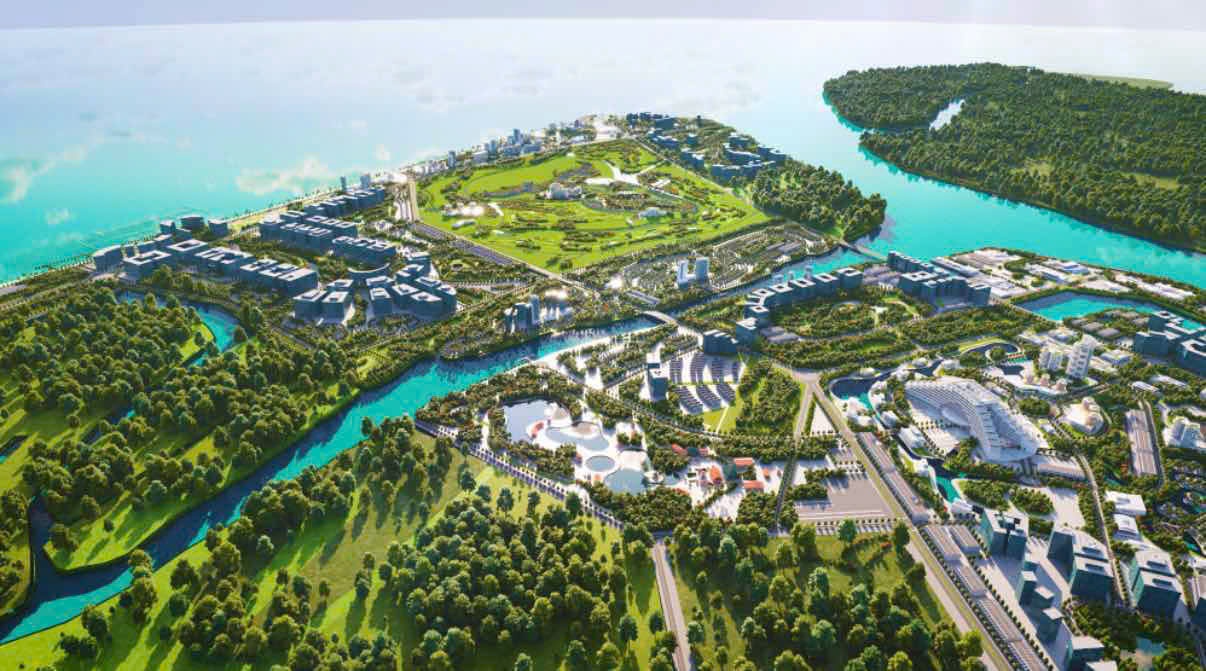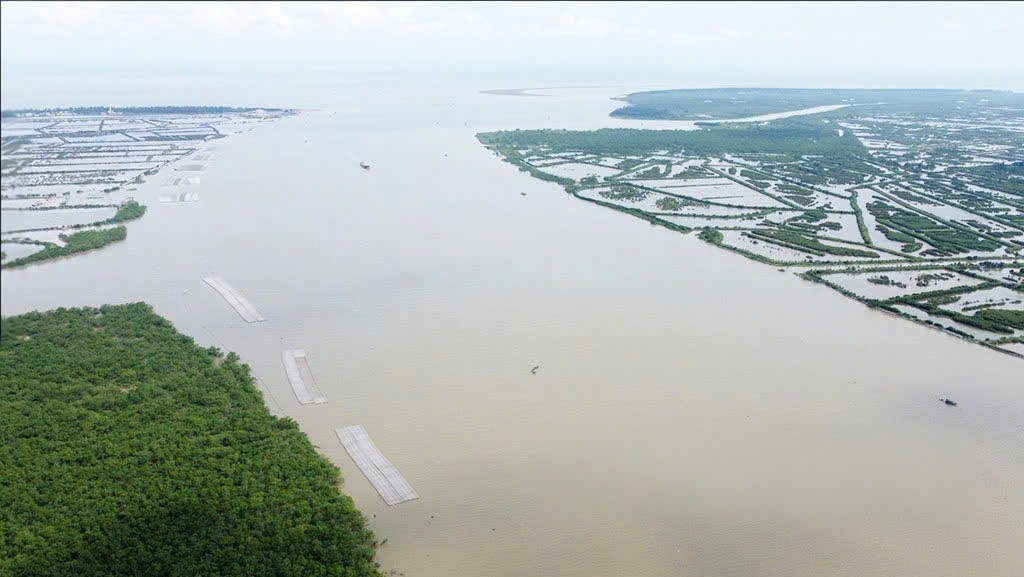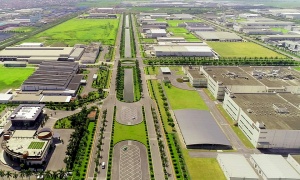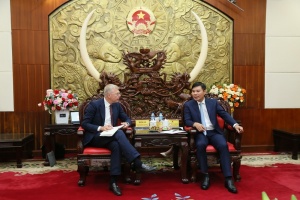At the end of June, a significant milestone was marked with the groundbreaking of the Ba Lat Liquid Cargo Port in Hung Phu commune.
 |
| The perspective of Ba Lat Liquid Cargo Port in Hung Yen |
Covering over 68,500 square metres, the port is designed to accommodate vessels of up to 3,000 tonnes and handle 150,000 tonnes of cargo annually. It includes nearly 5,000 sq.m of storage and synchronised technical infrastructure, ensuring the safe and efficient transport and storage of fuel on a large scale.
This port is more than just a logistics facility, it represents a strategic step in establishing a modern logistics network and boosting industrial development across the northern coastal region.
It also forms a critical part of Hung Yen’s broader infrastructure development strategy. Several key expressways are currently being expedited, including Expressway 16, which connects directly to Ba Lat Port; Expressway 8, linking Ninh Binh province and Haiphong city; and Expressway 39, which connects Hanoi’s Ring Road 5, national highways, and coastal roads.
The port is expected to provide a stable energy supply, lower transportation costs, and enhanced competitiveness of the province’s coastal areas. With infrastructure development paving the way, Hung Yen is already witnessing a fresh wave of investment, setting the stage for the Thai Binh Economic Zone to emerge as a nationally significant investment destination.
According to a representative from Phu Thanh Group, the project’s investor, Ba Lat Port is not only a specialised terminal for petrol and oil but also serves as “a highly competitive coastal logistics corridor effectively connecting the delta with the midlands and northern mountainous regions.”
The facility is envisioned as the initial link in an energy logistics chain connecting directly with industrial zones and factories within the Thai Binh Economic Zone. Over time, this chain could evolve into a large-scale cargo transshipment centre serving both domestic and international markets.
As outlined in the National Transport Infrastructure Master Plan to 2030, with a vision to 2050, Hung Yen is positioned to play a central role in interregional and interprovincial logistics.
The province is now planning and investing in a synchronised inland waterway port system along the Red, Tra Ly, Luoc, and Hoa rivers, all of which will be capable of handling ships of up to 3,000 tonnes.
Ba Lat Seaport, home to a liquid cargo port, is one of Hung Yen’s three major port areas under National Port Group No. 1. This positioning further strengthens the province’s ambition to become a regional coastal logistics centre.
In addition to seaports, Hung Yen has also laid out plans for four inland dry ports organised into two clusters: Nam Phu and Tan Truong in the east, and Hung Ha and Quynh Coi in the west. These will form a comprehensive cargo transport chain linking seaports with industrial parks and consumption markets via road and inland waterways.
Vu Kim Cu, head of the Hung Yen Economic Zone Management Board, highlighted the importance of ongoing investments in critical infrastructure such as seaports, dry ports, and coastal roads. Looking beyond 2030, the province is also exploring the development of a dedicated coastal airport.
“Proactive infrastructure development will enable Hung Yen to attract high-quality capital flows,” Cu said.
 |
| Ba Lat Liquid Cargo Port, located at the mouth of the Red River flowing into the East Sea, covers over 68,500sq.m. Photo: Khac Duan |
Ba Lat Liquid Cargo Port stands as a pioneering project in energy logistics, marking the beginning of a new development phase for the province.
With a gradually completed multimodal infrastructure network and a strategy focused on “leapfrogging and leading”, Hung Yen is working to elevate the Thai Binh Economic Zone into a fully integrated logistics-industrial-services centre. The goal is clear: to compete with and attract strategic investors from both domestic and international markets.
One of the province’s most ambitious proposals involves constructing a large-scale seaport in Diem Dien, capable of receiving vessels of up to 200,000 tonnes. If approved, the project would significantly expand Hung Yen’s marine economic space, strengthen its logistics connectivity, and drive development across the Thai Binh Economic Zone—one of the Red River Delta’s key multi-sector economic clusters.
The Ministry of Construction has voiced support for this proposal and has requested relevant agencies to finalise the project plan for submission to the prime minister.
Nguyen Khac Than, chairman of Hung Yen People’s Committee, said that the province’s strategic goal is to expand its marine economic space, with a central focus on transforming the Thai Binh Economic Zone into a vibrant multi-sector cluster. To realise this vision, the province is prioritising policy innovation, smart transport planning, synchronised connectivity, and the promotion of key economic sectors.
Beyond infrastructure, Hung Yen is also improving its investment climate by streamlining administrative procedures, preparing land in advance, accelerating site clearance, and offering ongoing support to businesses throughout their project lifecycles.
These efforts are yielding results. In the first eight months of 2025 alone, Hung Yen attracted over $6.3 billion across 243 new and expanded ventures. Of these, 144 were domestic direct investment (DDI) projects with registered capital exceeding $4.7 billion, while 99 were foreign direct investment (FDI) projects totalling nearly $1.6 billion in capital.
As of now, Hung Yen is home to 3,917 active ventures, including 903 FDI and 3,014 DDI projects, with total registered capital surpassing $41 billion. Notably, more than 1,100 of these projects are situated in industrial parks and economic zones, with 544 FDI and 581 DDI projects accounting for over $19 billion in investment.
With a bold vision and strategic infrastructure investments, Hung Yen is poised to assert itself as a force in Vietnam’s northern economic landscape.
 |
High-tech growth drives investment surge in Hung Yen
Hung Yen attracted over $840 million in investment in seven months, driven by industrial upgrades, policy reforms, and growing investor confidence in the province’s development prospects. |
 |
Dutch businesses keen to invest in Hung Yen
CTP Netherlands intends to develop industrial parks offering comprehensive services in diverse localities across Vietnam, including Hung Yen province. |
 |
Hung Yen charts path to modern, green growth
Hung Yen’s post-merger development promises to unlock vast coastal, industrial, and green economic potential, propelling the province towards a modern, sustainable, and globally connected future. |





